What is Tonkean?
Tonkean is an AI-powered process orchestration platform—it empowers business operations teams to create processes that people actually follow.
We help shared services teams like legal, procurement, and HR to solve the problems of poor process adoption, lack of compliance, and the low visibility into the health of your process that comes as a result. We've learned that if you focus on the experience of your internal requesters and create an intuitive, easy-to-follow process, those requesters actually want to use your preferred process, leading to huge efficiency gains, reduced costs, and greater compliance. These are the experiences we enable business ops teams to create.
To create these experiences and the processes behind them, business ops professionals leverage Tonkean's no-code workflow builder, AI tools, and data source connections. Rather than replace the systems that are working for you, Tonkean wraps around your existing systems and policies, allowing you to unlock additional value and orchestrate complex processes that involve both data and people.
The Tonkean platform gets its name from the Tonkean macaque, a species of monkey native to Indonesia. Tonkean macaques are known for working together as a team to resolve conflicts and accomplish their goals. This collaborative spirit is exhibited not only in how Tonkean coordinates systems and people to accomplish a goal, but internally, where the whole Tonkean team pitches in to make lives better for our users.
While Tonkean is flexible enough to handle a wide variety of use cases, our most successful makers leverage Tonkean to orchestrate processes characterized by a common formula: request intake, triage and coordination, and resolution. This is the underlying structure of most internal team processes, whether they're designed to field legal requests or guide users through a guided buying experience.
For example, maybe your legal team accepts requests by email (legal@acme.com). While many different requests are received here, the most common is an NDA request for a prospect. Instead of requiring people to manually read the email, duplicate the NDA template, copy and paste the prospect's information, then send the email to the requester, a Tonkean module will read the email with natural language processing, generate the NDA using data enriched by your existing systems, and then send it to the requester—all behind the scenes without the need for anyone to be involved.
But what happens if the NDA request wasn't standard? That's where Tonkean keeps people in the loop. The Tonkean module will contact the appropriate user and give them various actions to take, wherever they like to work (email, Slack, Teams). In this way, Tonkean effectively balances process automation and the people who can handle exceptions to the usual processes to ensure nothing falls through the cracks.
The Maker Mindset
Before diving in and learning about the technology that makes Tonkean so powerful, it's helpful to first understand the philosophy that powers the platform, what we call the "maker mindset."
The maker mindset is a philosophy that makers cultivate as they customize workflows on the platform—a way of seeing and understanding problems that's powered by a certain technical curiosity and belief that there's always a way.
A maker may not know how to write in any particular programming language, but with our no-code builder, they don't have to know; they still understand many of the same high-level concepts as programmers. More than that, they're willing to get their hands dirty. A maker looks at a problem in their organization and thinks "I could probably make something to fix this."
With the maker mindset, you think through a problem or process from different levels, ask a series of questions to help clarify what exactly you're trying to accomplish, and then work backward to figure out the steps to get there.
To start developing a maker mindset, you can ask yourself these questions about your process before you start working hands-on in Tonkean:
At a high level, what am I trying to accomplish? What is my end goal? This is the overall problem you're working to solve. To return to our legal department example from earlier, this might be providing NDA forms to prospective clients to help cut down on the manual work the legal team has to do. Even a simple goal of saving 10 hours per week spent responding to these common requests can snowball into huge efficiency gains.
What information do I need to accomplish my goal? What data or systems do I need access to? Once you know what you're trying to accomplish, you need to determine what data you need. This may be as simple as getting access to an email inbox or as complicated as pulling data together from multiple apps (e.g. pulling content from Salesforce to create a Jira ticket and then notifying a team member of that creation in Slack, etc.). There's no need to detail the connections quite yet—just determine what resources you think you need.
In what order do I need to connect the different apps or systems? How would the process flow from start to finish? You know what information you need and where you need to get that information, and now you need to map out what the flow might look like. It's helpful to figure out where your process can be handled entirely by machines and where you need to keep the people involved. We find that mapping things out with a pencil and paper can be helpful, or even collaborating with your teammates with a whiteboard session. Once you've figured out the overall flow of your solution, you should have a fairly clear idea of what the solution might look like in Tonkean.
Where is my process most likely to break down or run into problems? As a last step before you get hands-on, it's important to outline where the problems are likely to come up. For example, if you're monitoring an email inbox for NDA requests, could you run into a problem where the requester uses terms you're not expecting to ask for an NDA? Natural variations in language and even non-native speakers can phrase things in ways you might not anticipate. Or, on the other end of your flow, will you always pull your NDA form from the same place? Or could that change? Heading off some of these problems in the planning stages can pay huge dividends later.
Core Concepts and Common Terms
As a platform, Tonkean is composed of several distinct parts that work together to form end-to-end solutions. Understanding these parts and the overall architecture of Tonkean will allow you to organize your connections, connect your data sources, and automate your processes to create the complete process experience that suits your specific needs.
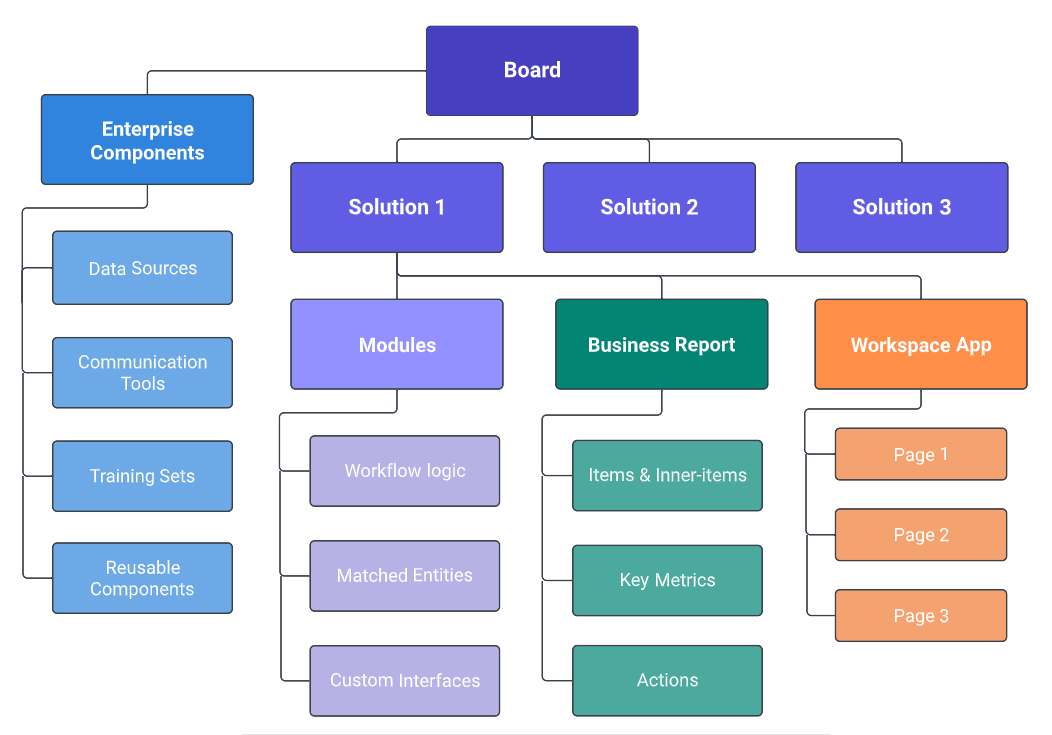
Board
A board is the highest point in the Tonkean hierarchy and can contain many solutions. Boards are usually specific to an entire enterprise, with one board containing all the solutions for that enterprise. If your organization has unique needs surrounding business unit structure, reporting needs, or governance, you can organize your content into multiple boards.
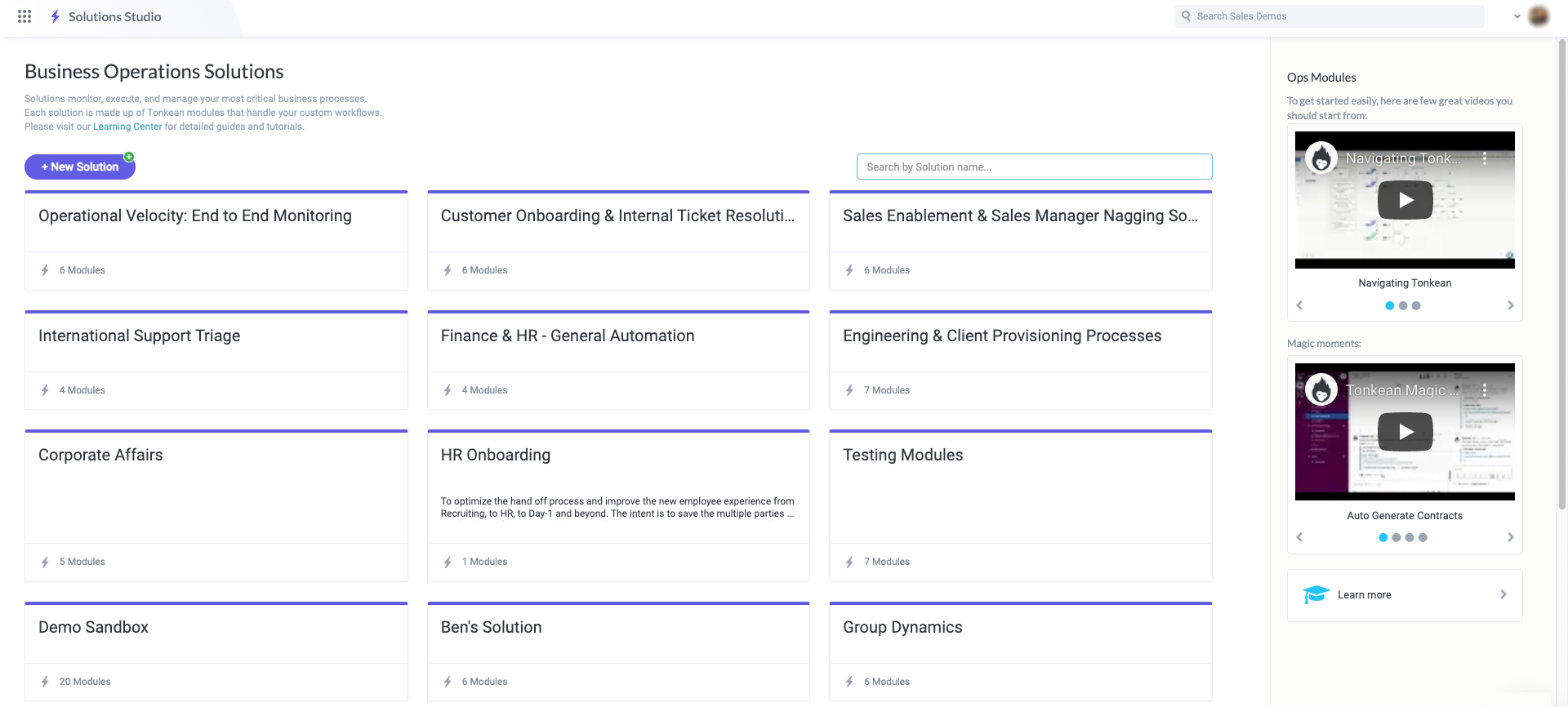
Solution
The solution is the core of the Tonkean platform: it contains the description of a business problem, the planned and ongoing approach to solve that problem, and all the logic (that is, the modules and enterprise components) that address the business problem. Solutions also include the workspace app and business report, which allow users to gain important insights into the overall process.
Put simply, a solution allows you to accurately describe a business problem, flesh out and iterate on a solution to that problem, and respond to ongoing changes. You can create a solution from the ground up or find ready-to-go solution blueprints in the Component Library, giving you a jump-start on common use cases.
Because they can be endlessly customized, solutions can vary greatly from use case to use case, but many address common problems, such as automatically handling requests from multiple channels or coordinating processes between departments. Below are some of the most common solutions:
Legal intake, triage, and coordination
New employee onboarding
Email inbox request coordination
Purchasing approval
Customer support ticket triage
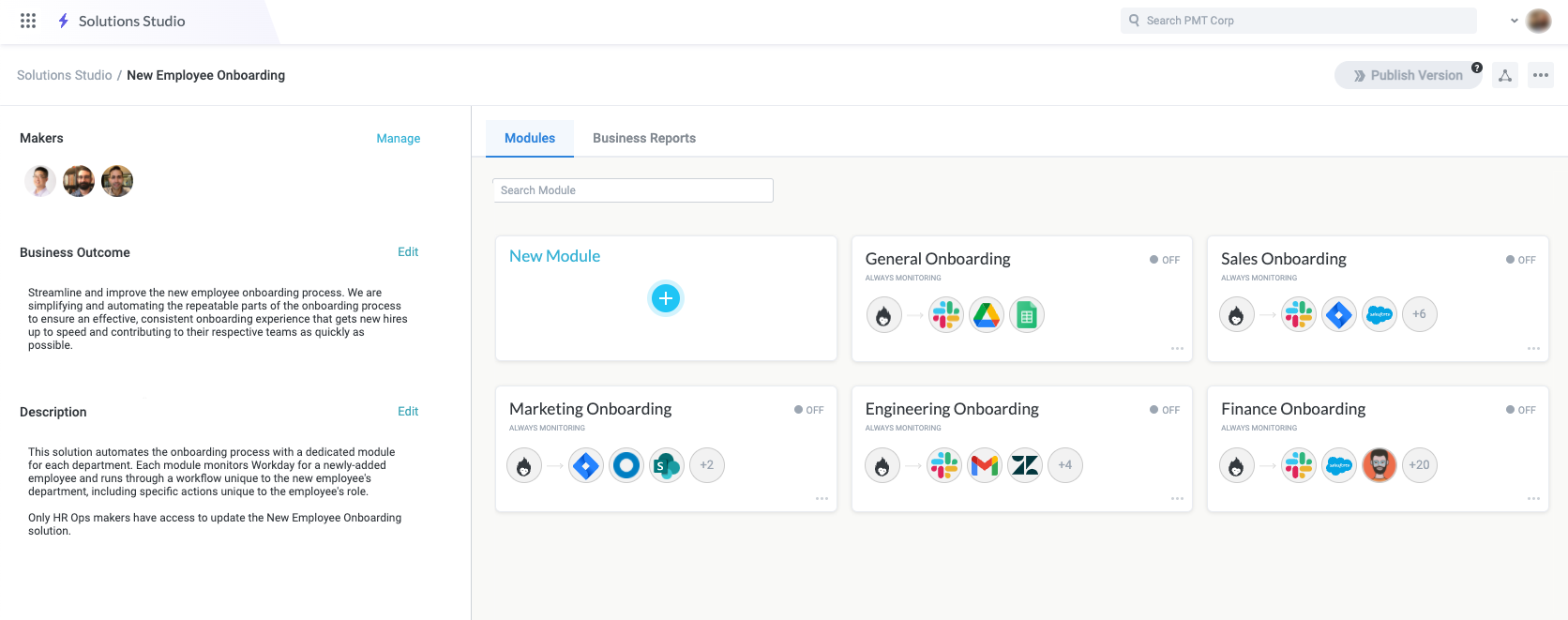
Module
Each solution is made of modules. Modules house all the custom workflows, connect all of your data sources together, and give you the power to take actions based on the criteria you set up. Within each module, Tonkean provides you the ability to say "when" an event happens, the module takes specific actions.
Modules are typically built and organized as distinct, operational workflows or automations that orchestrate business processes between people, systems, and applications. This organization allows modules to remain simple to understand as they are iterated on and enhanced over time.
For example, a new employee onboarding solution could have the following modules:
Request system access from the hiring manager
Notify new hires of mandatory training
Create and triage IT tickets for new hires
Often, a solution will have a process broken out into several modules, effectively componentizing the workflow. For example, a legal request intake and triage solution may have the following modules:
Email request intake
Slack request intake
Request processing and triage
Legal approval
In these kinds of processes, distinct parts of the process are separated to simplify updates and make troubleshooting easier.
You can create modules from the ground up or find ready-to-go module templates in the Component Library, giving you a jump-start on common use cases.

Data Source
Within each board, admins have access to various enterprise components, the building blocks that support and enable your workflows. The most important of these enterprise components is data sources. These include over 150 native cloud applications you can connect using OAuth, service account, or API key. Popular data sources include Google Drive, Gmail, Salesforce, Jira, Zendesk, and Slack. For any non-SaaS or non-cloud-based data source you want to connect (such as custom databases or internal APIs), you can leverage webhooks to integrate them as custom data sources or even create your own no-code data sources.
Tonkean monitors these connected data sources for any changes and responds based on the business logic you configure. By integrating directly with your data sources, you can orchestrate complex workflows across multiple systems.
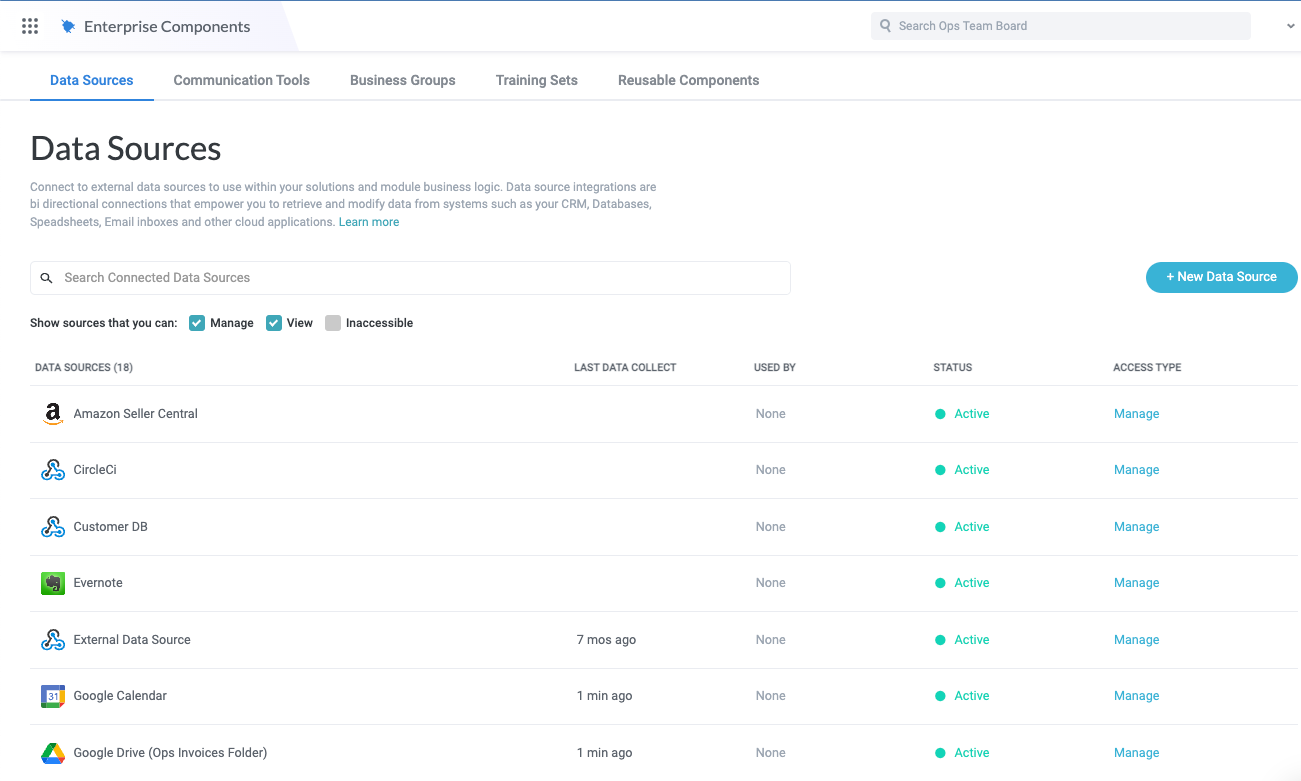
Triggers and Actions
Triggers function like "when" statements. At least one trigger must be created for a module to work, but the trigger can range in complexity from beginning a process when a new item is created (such as a new Salesforce opportunity) to containing numerous "if" statements that target specific conditions (such as only opportunities that fit certain parameters).
Actions are the "then" statements that respond to triggers and represent various processes in Tonkean—everything from updating fields in a connected system or sending a message to a stakeholder.

Matched Entities
Many records in your applications and systems are related. Matched entities take a piece of data from one system and match it to a piece of data in another system to create a link between those records (for example, you might connect a user name in a Google sheet to a username database to move data between the two places). Once the match has been made, you’re then able to pull in all respective data and metadata from your connected data sources. Matched entities are one of the most flexible and powerful features of Tonkean.
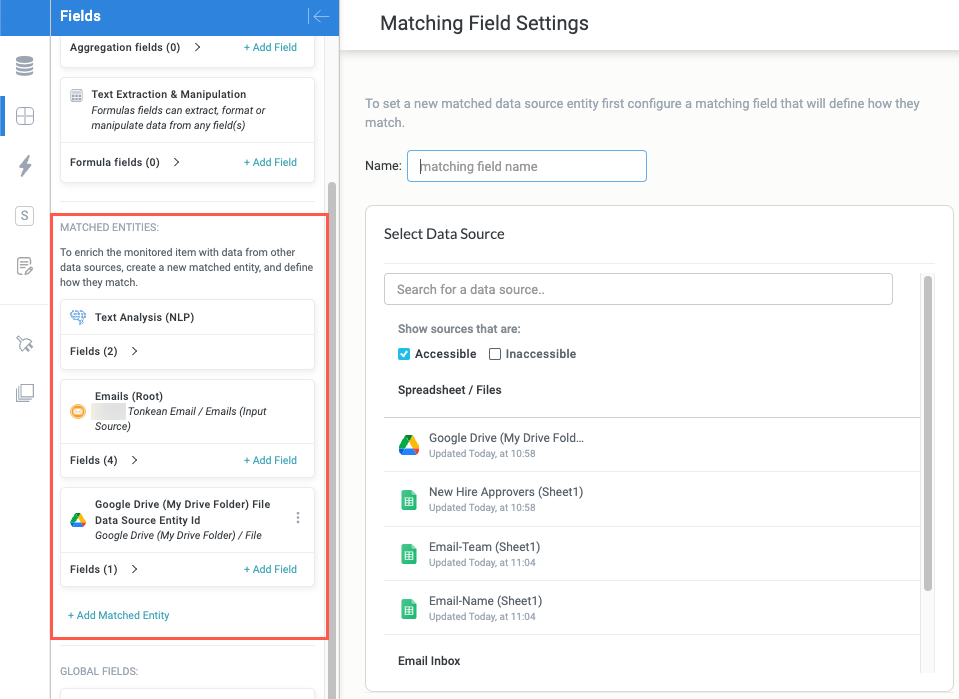
Custom Interfaces
Custom item interfaces (or, simply, custom interfaces) provide a way to display and interact with an item (request). Interfaces can provide form experiences that you can combine into a sequence to create form flows for request intake or review processes; they can also provide read-only views of an item that provide important information to the people involved in your business process. Custom interfaces are built using a drag-and-drop, widget-based builder, and can include a wide variety of elements like fields, status trackers, charts, line items, and much more.

Workspace Apps
Workspace apps are the face of a Tonkean solution, providing a user experience for all the actions, data, and business logic at work within that solution. Across multiple pages, workspace apps not only provide a way to interact with your solutions, but also illustrate their value to process contributors, helping to highlight process improvements, cost savings, or other key metrics that are important to your team and organization.
Workspace apps are often designed as central dashboards for shared services teams that provide a way for users to submit requests and track those requests through to resolution. Additionally, you can create specialized metrics that provide valuable insight into your various processes.

Business Reports
Each module has its own business report, which consists of data columns and the items your module is monitoring—they can also provide key metrics, which are aggregate fields that provide a holistic view of important values.
Business reports pull in data from various data sources, providing constant monitoring, and can also provide direct access to module actions. For example, if your module intake source is a request form, you can submit that form directly from the business report.
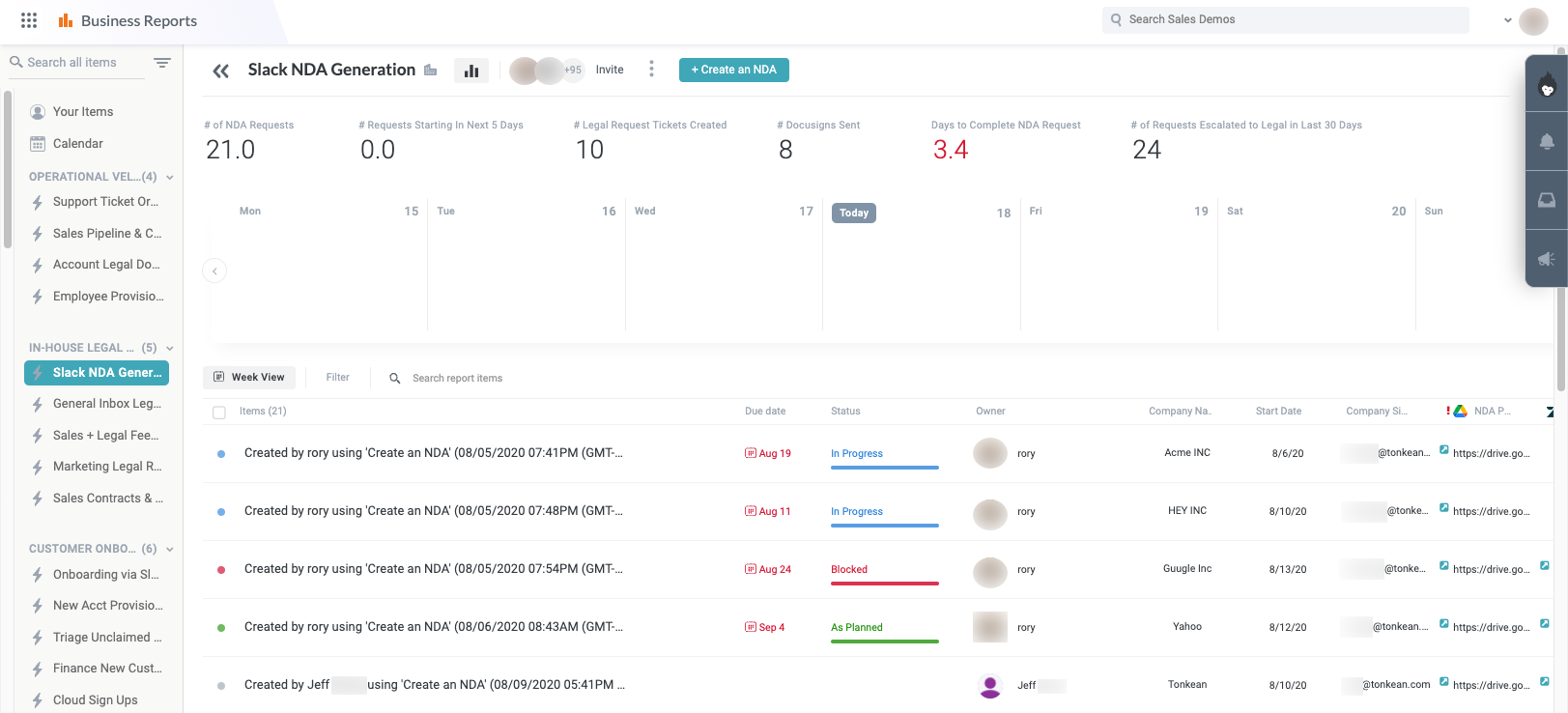
Items and Inner items
Items are the pieces of data that the module will take action on, and inner items are simply children of items. This is the important data you are constantly monitoring. In most cases, items are the requests submitted by internal users for service, such as purchase requests for the procurement team or contract requests for the legal team. Another way to think of items is as a row in a spreadsheet, with columns providing important pieces of information about each item. It might have a customer name pulled from Salesforce, that same customer's total payments made amount from Stripe, and their NPS score from Zendesk, all pulled within a single report in Tonkean.
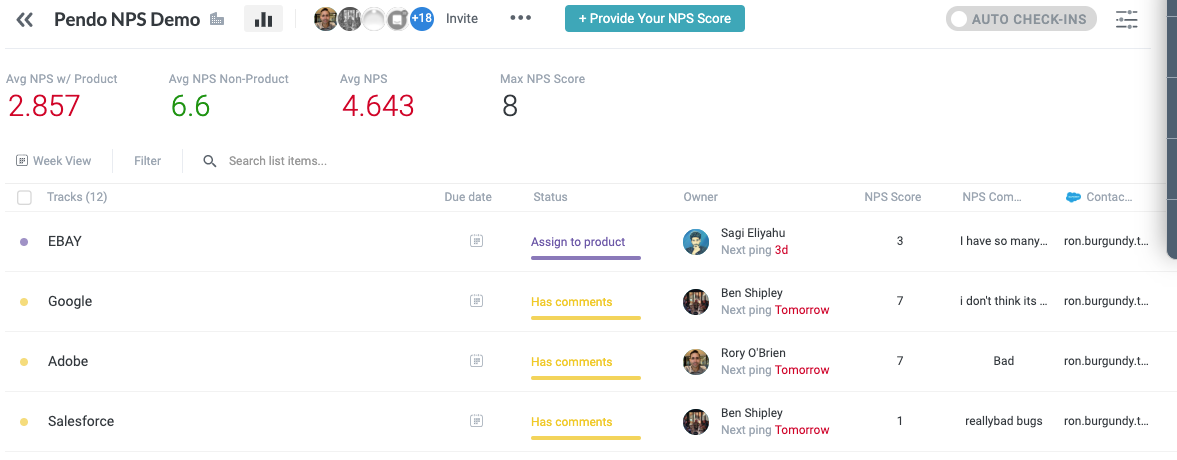
Fields
Fields are individual pieces of data created by and/or used in your workflow. There are various kinds of fields—fields can be pulled in from a connected data source (like Salesforce opportunity name, Salesforce opportunity amount, Intercom Tags, Zendesk ticket number, and so on) or created in Tonkean and their values populated during a workflow (for example, a user entering a purchase price into a Price field.
Common examples of fields are those populated during a request intake journey, such as, for a legal contract request, the Contract Type, Needed By Date, and more. As users complete the intake form, they populate these fields with data, which are then used in the workflow.
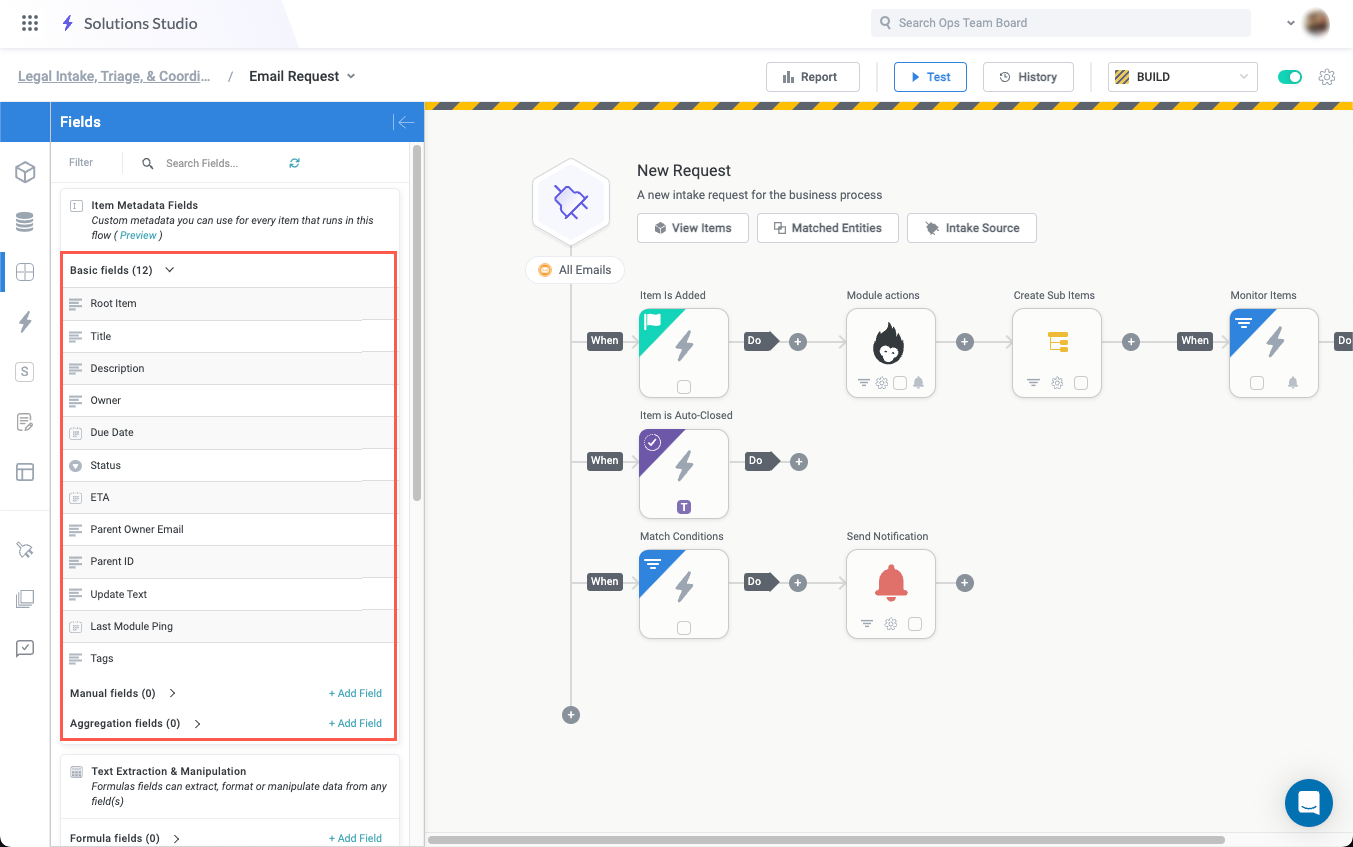
Key Metrics
These are the formulas and calculations you can aggregate for the data in your data set. Continuing with the spreadsheet example, you might want to do a sum of all the tail spend under a certain dollar amount, or a count of all your open Zendesk tickets. These are metrics that dynamically calculate for your entire data set, for which you can then create a report or create modules to take action based on the values of the metrics.
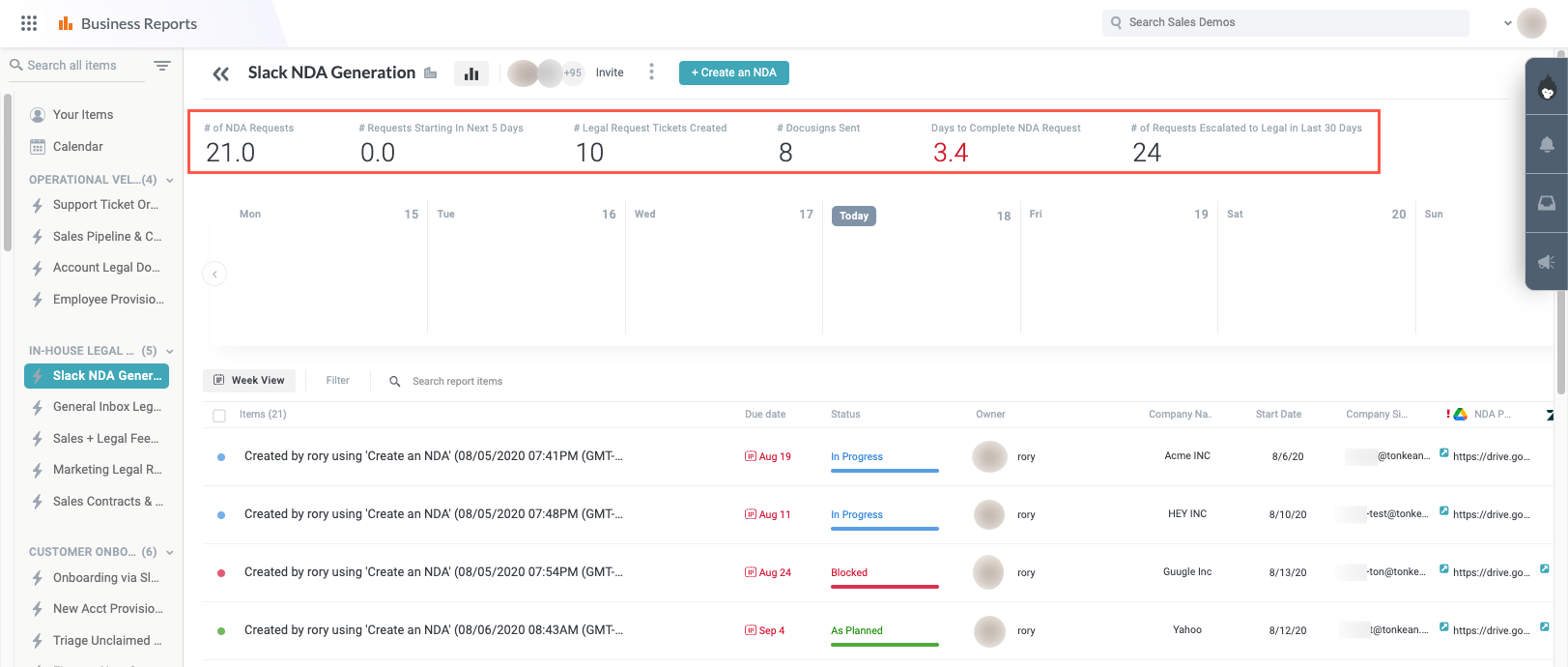
Learn More
To learn more about the basics of Tonkean, visit another one of the topics below:
If you're ready to customize your first module and start automating your unique process, check out the Tonkean Maker Course.